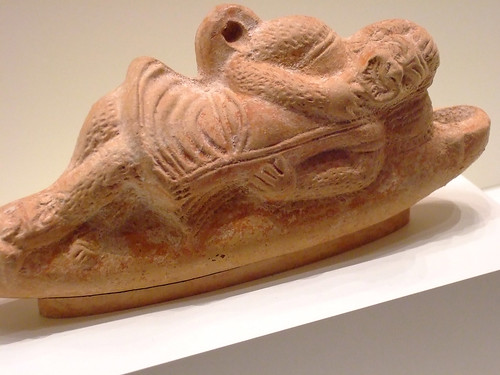
From the description of the site, it sounds like a sewn ship will be the first of numerous discoveries in the former Roman city of Cissa.
I wonder if this new discovery exhibits the combination of construction techniques found in a Greek vessel raised off the coast of Sicily late last year? That 2500 year-old vessel was built with both sewing and mortise-and-tenon joints. According to National Geographic, other finds show that Egyptians and Phoenician-Punic people used this method of boat building as well.
Archaeologists have found an ancient sewn ship over 2000 years old in Novalia, Croatia. The ship, including body panels, ship skeleton and stitches, was found in the Caska Bay on the Island of Pag, near Novalja.
[Image - Reconstruction of a sewn boat. Courtesy of The Sewn Boat homepage.]“In Roman times, Novalja was known for its port accommodation and was located on the old sea route from Greece to northern Italy and central Europe. The ships would wait in Novalja for suitable winds and because of that a town developed there that had various suitable services,” said professor Zdenko Brusic from Zadar University.
“Today, there are numerous remains of Roman architecture under the whole region, like water supply lines, well equipped basilicas, graves,” he added. - More: Sindh Today
On the Sewn Boat Homepage, Misha Naimark explains that the stitching material for sewn boats (at least those built in Northern Europe) was usually made from the roots of trees like spruce or pine.
Gathered roots must be cleaned from the bark (which is also loose and peels off quite easily) and immediately immersed into a bucket of tar; the roots are soft only while they are fresh and wet, but when they get dry they become quite crisp and stiff. So the roots are to be kept immersed in the tar, and taken out just before sewing. To protect them against rotting and deteriorating in the boat, the roots must be boiled in the tar until they are completely impregnated with it; this will make them softer, too.
Thus prepared, the spruce roots are flexible enough for sewing; but if a root is too thick and stiff, one can easily rip it lengthwise into two equal thong-like parts, which are very fit for sewing. Each part can further be ripped into halves to obtain thin and flexible enough yarns. Usually thick roots were split into yarns this way, and sometimes several such yarns were twisted together into strands and used for sewing instead of whole roots. - More: The Sewn Boat Homepage


